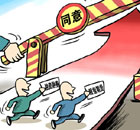Opinion
Beware of new bubbles and act
By Ding Yifan (China Daily)
Updated: 2009-12-04 07:57
 |
Large Medium Small |
The recent rapid rises in real estate and stock prices in China and some other Asian nations have led to fears that bubbles might have emerged in the two sectors.
The latest round of property price hikes in Asian nations is largely related to proactive financial and loose monetary polices, which have catalyzed excess liquidity. In China, for example, over the past five years, M2 supply in Asia's second-largest economy has maintained an average 17 percent annual growth rate and is expected to exceed 30 percent this year. Due to gloomy external economic prospects and widespread worries about investment risks in the bleak manufacturing sector, the real estate market is regarded as an investment paradise. At the same time, people's worries that the country's relaxed monetary policy will possibly fuel inflation have also contributed to the rush for panic house buying to ward off effects of a possible inflation rise and keep their assets from being devalued.
Despite people's growing expectations of inflation, the consumer price index (CPI) is not expected to ascend steeply anytime soon. This is because manufacturers want to sell their stockpiled products as soon as possible in the face of a possible economic slowdown and consumption contraction, which will inevitably prompt them to cut prices amid severe market competition. In the absence of pressure from inflation, the central banks in Asia are unlikely to call an end to the loose monetary policy as the main tool to check a lingering slump. As a result, growing liquidity will push property prices further up.
Since the 1997 Asian economic crisis, there has been widespread debate among economists on whether central banks should take rapid property price rises as the weathervane for adjustment of monetary policies. The overwhelming consensus is that it is difficult to judge what extent of property price expansion is abnormal. Only a few claim that central banks should take property price rises into account when making monetary policies. In the context of the global economic slowdown, it is a big challenge for central banks to choose the right timing to exit from economic stimulus packages aimed at boosting economic growth.
As the world's third-largest economy and a robust and alluring emerging market, China has seen a continuous inflow of outside capital, which has added to excess liquidity. Recent Hong Kong statistics indicate that about HK$500 billion ($64.52 billion) of international hot money flowed into the region during the past year, which most people believe is mainly targeted at the bigger mainland market. The actual negative dollar interest rate adopted by the US administration has also driven some financial institutions to borrow to invest in China's property market. In addition, the so-called low exchange rate of China's currency is seen by some international speculators as offering an opportunity to profiteer if they choose to invest in the country and await the renminbi's appreciation. The China investment rush has added much to the difficulties of China's currency policy. When Banking Regulatory Commission Chairman Liu Mingkang lashed out at US monetary policy not long ago and denounced Washington's currency tools as an irresponsible act that has contributed to international speculation in China, we understand the concerns of the country's banking regulator.
More than a decade after the 1997 Asian crisis, people still shudder when financial bubbles are mentioned. However, history indicates they have always been accompanied by a new round of economic growth. In the US, for example, railway construction in its history of development resulted in the formation of bubbles as a result of issuance of railway bonds, but the well-developed railway network did help lay a solid foundation for the high-paced development of the US economy despite the busting of the bubbles later. The rapid development of telegraph and telephone technologies in the US also catalyzed financial bubbles in the country, but the large-scale capital inflow to the two sectors also boosted the development of US telecommunication technologies after the bubbles burst, which helped the US gain a sharp technological edge over other countries. The case was the same in information technology development in the 1990s.
At a time when the government is building high-speed railways nationwide and developing green industries, we could increase issuance of railway securities and create favorable conditions for well-performing and green industries to be listed. Also, the country should set up a capital flow firewall and stop quick large-scale capital outflows should investor confidence plunge.
The author is a researcher at the Development Research Center under the State Council.













